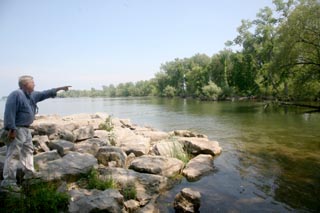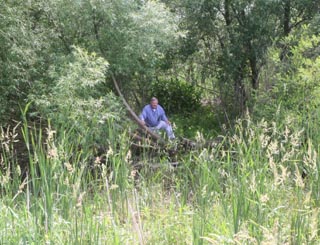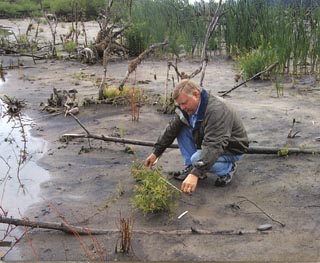
Ed Evans walks two miles of the Lake Ontario shoreline everyday. He has different gear packed in his car to accommodate different weather like blizzards or some rain and lightning , and regardless of what Mother Nature throws his way, Evans is prepared to walk. He admits that he is a creature of habit. “If I skip one day I might skip another,” said Evans, former Hamlin Town Board member and retired Hilton High School Earth Science teacher. “Next thing you know I’d take a week off.” After logging in all that time and all those miles, Evans believes that Hamlin Beach State Park is a natural resource worth fighting for. That’s why he started a campaign a little over a decade ago that led to the construction of an 1,835 ft. breakwall to secure Yanty Marsh. The pounding of Lake Ontario’s waves was destroying the marsh. In May of 1997 there was only about one foot of dryness between the lake and the marsh, for stretches of hundreds of feet there was no longer any separation. Today, Evans skips along the top of the rock wall admiring how nature seems to be progressing. The great big rocks seem to be settling together and the waves have carried sediment through the wall’s cracks to recreate a protective barrier for the marsh. Vegetation is returning to the marsh’s edge in distinctly beautiful ways. “Some experts have said that this project has worked out more according to plan than any similar project,” Evans said. “This is one truly impressive natural habitat.” The habitat’s worth was confirmed in a biological survey conducted by Joseph C. Makarewicz, SUNY Brockport professor, in 2000. As far as wildlife, Makarewicz found that the marsh was home to nine species of plants that have received special status from New York state: the Peregine Falcon, which is an endangered bird; the Bald Eagle and Pied-billed Grebe, two threatened birds; and several important fish species. As he surveys the 93 acres of pristine marsh, Evans’ joy is tempered by the fear that all of this work may have been for nothing. There was supposed to be a second phase of the project, which would include a wall protecting the east end of the marsh. It was proposed in 2001 and then again in 2006; the latter being documented in an environmental assessment draft authored by the Environmental Management Bureau. In there, the report calls for a second wall east of the Yanty Marsh’s mouth that would stretch 2,860 ft. long, be 53 ft. wide and 5.8 ft. high. “We’re going to have an 1,835 ft. pier running the wrong way if the other side doesn’t get built,” said Evans. And that is too depressing for Evans to take, especially after seeing all of the progress that has been made by the marsh over the last decade. “It is one of the few wetlands where you can see nature doing what nature is supposed to be doing,” said Evans, adding that Yanty Marsh is one of only two marshes of its kind still in existence on the south shore of Lake Ontario. “The eastern most end looks just like the area that was breached in the spring of 1998,” said Evans. And as time passes, the waves creep closer to the marsh. © July 8, 2007 - Westside News Inc. |



